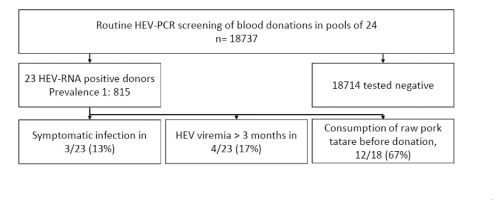当前位置:
X-MOL 学术
›
J. Hepatol.
›
论文详情
Our official English website, www.x-mol.net, welcomes your
feedback! (Note: you will need to create a separate account there.)
HEV positive blood donations represent a relevant infection risk for immunosuppressed recipients
Journal of Hepatology ( IF 26.8 ) Pub Date : 2018-07-01 , DOI: 10.1016/j.jhep.2018.02.031 Dirk Westhölter , Jens Hiller , Ulrike Denzer , Susanne Polywka , Francis Ayuk , Meike Rybczynski , Thomas Horvatits , Svantje Gundlach , Johanna Blöcker , Julian Schulze zur Wiesch , Nicole Fischer , Marylyn M. Addo , Sven Peine , Burkhard Göke , Ansgar W. Lohse , Marc Lütgehetmann , Sven Pischke
Journal of Hepatology ( IF 26.8 ) Pub Date : 2018-07-01 , DOI: 10.1016/j.jhep.2018.02.031 Dirk Westhölter , Jens Hiller , Ulrike Denzer , Susanne Polywka , Francis Ayuk , Meike Rybczynski , Thomas Horvatits , Svantje Gundlach , Johanna Blöcker , Julian Schulze zur Wiesch , Nicole Fischer , Marylyn M. Addo , Sven Peine , Burkhard Göke , Ansgar W. Lohse , Marc Lütgehetmann , Sven Pischke

|
BACKGROUND & AIMS
Routine HEV testing of blood products has recently been implemented in Great Britain and the Netherlands. The relevance of transfusion-transmitted HEV infections is still controversially discussed in Europe. METHODS
All blood donations at the University Medical Center Hamburg-Eppendorf were prospectively tested for HEV RNA by pooled PCR from October 2016 to May 2017. Reactive samples were individually retested. Additionally, stored samples from previous donations of positive donors were tested to determine the duration of HEV viraemia. HEV RNA-positive donors and a control cohort were asked to answer a questionnaire. RESULTS
Twenty-three out of 18,737 HEV RNA-positive donors were identified (0.12%). Only two of the positive donors (8.7%) presented with elevated aminotransferases at time of donation (alanine aminotransferase: 192 and 101 U/L). The retrospective analysis of all positive donors revealed that four asymptomatic donors had been HEV viraemic for up to three months with the longest duration of HEV viraemia exceeding four months. Despite the HEV-testing efforts, 14 HEV RNA-positive blood products were transfused into 12 immunocompromised and two immunocompetent patients. One recipient of these products developed fatal acute-on-chronic liver failure complicated by Pseudomonas septicemia. The questionnaire revealed that HEV RNA-positive donors significantly more often consumed raw pork meat (12 out of 18; 67%) than controls (89 out of 256; 35%; p = 0.01). In two donors, undercooked pork liver dishes were identified as the source of infection. HEV genotyping was possible in 7 out of 23 of HEV viraemic donors and six out of seven isolates belonged to HEV Genotype 3, Group 2. CONCLUSIONS
Prolonged HEV viraemia can be detected at a relatively high rate in Northern German blood donors, leading to transfusion-transmitted HEV infections in several patients with the risk of severe and fatal complications. Eating raw pork tartare represented a relevant risk for the acquisition of HEV infection. LAY SUMMARY
The relevance of transfusion-transmitted hepatitis E virus infections has been discussed controversially. Herein, we present the first report on routine hepatitis E virus screening of blood donations at a tertiary care centre in Germany. Hepatitis E viraemia was found at a relatively high rate of 0.12% among blood donors, which represents a relevant transfusion-related risk for vulnerable patient populations.
中文翻译:

HEV 阳性献血代表免疫抑制受者的相关感染风险
背景和目的 最近在英国和荷兰实施了血液制品的常规 HEV 检测。在欧洲,输血传播的 HEV 感染的相关性仍然存在争议。方法 2016 年 10 月至 2017 年 5 月,汉堡-埃彭多夫大学医学中心的所有献血均通过混合 PCR 进行了 HEV RNA 前瞻性检测。反应性样本单独重新检测。此外,还对来自阳性捐赠者先前捐赠的储存样本进行了测试,以确定 HEV 病毒血症的持续时间。HEV RNA 阳性供体和对照组被要求回答问卷。结果 18,737 名 HEV RNA 阳性捐献者中有 23 名(0.12%)被确定。只有两名阳性捐赠者 (8.7%) 在捐赠时出现转氨酶升高(丙氨酸转氨酶:192 和 101 U/L)。对所有阳性捐献者的回顾性分析显示,4 名无症状捐献者的 HEV 病毒血症持续时间长达 3 个月,其中 HEV 病毒血症的最长持续时间超过 4 个月。尽管进行了 HEV 测试,但仍将 14 种 HEV RNA 阳性血液制品输入 12 名免疫功能低下的患者和 2 名免疫功能正常的患者。这些产品的一名接受者出现致命的急性慢性肝功能衰竭,并发假单胞菌败血症。问卷显示,HEV RNA 阳性供体比对照组(256 人中的 89 人;35%;p = 0.01)更常食用生猪肉(18 人中有 12 人;67%)。在两名捐赠者中,未煮熟的猪肝菜被确定为感染源。23 名 HEV 病毒血症捐献者中有 7 名可以进行 HEV 基因分型,7 个分离株中有 6 个属于 HEV 基因型 3 第 2 组。几名有严重和致命并发症风险的患者传播 HEV 感染。食用生鞑靼猪肉是感染 HEV 的相关风险。常规总结 输血传播戊型肝炎病毒感染的相关性一直存在争议。在此,我们提出了德国一家三级医疗中心献血常规戊型肝炎病毒筛查的第一份报告。在献血者中发现戊型肝炎病毒血症的比率相对较高,为 0.12%,
更新日期:2018-07-01
中文翻译:

HEV 阳性献血代表免疫抑制受者的相关感染风险
背景和目的 最近在英国和荷兰实施了血液制品的常规 HEV 检测。在欧洲,输血传播的 HEV 感染的相关性仍然存在争议。方法 2016 年 10 月至 2017 年 5 月,汉堡-埃彭多夫大学医学中心的所有献血均通过混合 PCR 进行了 HEV RNA 前瞻性检测。反应性样本单独重新检测。此外,还对来自阳性捐赠者先前捐赠的储存样本进行了测试,以确定 HEV 病毒血症的持续时间。HEV RNA 阳性供体和对照组被要求回答问卷。结果 18,737 名 HEV RNA 阳性捐献者中有 23 名(0.12%)被确定。只有两名阳性捐赠者 (8.7%) 在捐赠时出现转氨酶升高(丙氨酸转氨酶:192 和 101 U/L)。对所有阳性捐献者的回顾性分析显示,4 名无症状捐献者的 HEV 病毒血症持续时间长达 3 个月,其中 HEV 病毒血症的最长持续时间超过 4 个月。尽管进行了 HEV 测试,但仍将 14 种 HEV RNA 阳性血液制品输入 12 名免疫功能低下的患者和 2 名免疫功能正常的患者。这些产品的一名接受者出现致命的急性慢性肝功能衰竭,并发假单胞菌败血症。问卷显示,HEV RNA 阳性供体比对照组(256 人中的 89 人;35%;p = 0.01)更常食用生猪肉(18 人中有 12 人;67%)。在两名捐赠者中,未煮熟的猪肝菜被确定为感染源。23 名 HEV 病毒血症捐献者中有 7 名可以进行 HEV 基因分型,7 个分离株中有 6 个属于 HEV 基因型 3 第 2 组。几名有严重和致命并发症风险的患者传播 HEV 感染。食用生鞑靼猪肉是感染 HEV 的相关风险。常规总结 输血传播戊型肝炎病毒感染的相关性一直存在争议。在此,我们提出了德国一家三级医疗中心献血常规戊型肝炎病毒筛查的第一份报告。在献血者中发现戊型肝炎病毒血症的比率相对较高,为 0.12%,











































 京公网安备 11010802027423号
京公网安备 11010802027423号